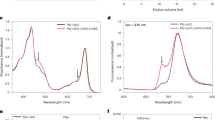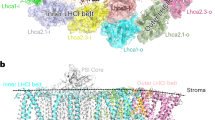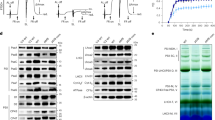Abstract
Photosystem I of the moss Physcomitrella patens has special properties, including the capacity to undergo non-photochemical fluorescence quenching. We studied the organization of photosystem I under different light and carbon supply conditions in wild-type moss and in moss with the lhcb9 (light-harvesting complex) knockout genotype, which lacks an antenna protein endowed with red-shifted absorption forms. Wild-type moss, when grown on sugars and in low light, accumulated LHCB9 proteins and a large form of the photosystem I supercomplex, which, besides the canonical four LHCI subunits, included a LHCII trimer and four additional LHC monomers. The lhcb9 knockout produced an angiosperm-like photosystem I supercomplex with four LHCI subunits irrespective of the growth conditions. Growth in the presence of sublethal concentrations of electron transport inhibitors that caused oxidation or reduction of the plastoquinone pool prevented or promoted, respectively, the accumulation of LHCB9 and the formation of the photosystem I megacomplex. We suggest that LHCB9 is a key subunit regulating the antenna size of photosystem I and the ability to avoid the over-reduction of plastoquinone: this condition is potentially dangerous in the shaded and sunfleck-rich environment typical of mosses, whose plastoquinone pool is reduced by both photosystem II and the oxidation of sugar substrates.
This is a preview of subscription content, access via your institution
Access options
Access Nature and 54 other Nature Portfolio journals
Get Nature+, our best-value online-access subscription
$29.99 / 30 days
cancel any time
Subscribe to this journal
Receive 12 digital issues and online access to articles
$119.00 per year
only $9.92 per issue
Buy this article
- Purchase on Springer Link
- Instant access to full article PDF
Prices may be subject to local taxes which are calculated during checkout







Similar content being viewed by others
Data availability
Genomic sequence data from this article can be found in the GenBank/EMBL data libraries (https://www.ncbi.nlm.nih.gov/refseq/) and Phytozome v.12.1.6 (Plant Comparative Genomics portal of the Department of Energy’s Joint Genome Institute) (https://phytozome.jgi.doe.gov/pz/portal.html) under the following accession numbers: XM_001756491 (Pp1s252_28V6.1) for lhcb9.1 and XM_001779101 (Pp1s23_96V6.2) for lhcb9.2. Protein sequence data identified by MS can be found in the online database UniProt (https://www.uniprot.org/). All the accession numbers are indicated in Supplementary Table 3.
References
Pinnola, A. & Bassi, R. Molecular mechanisms involved in plant photoprotection. Biochem. Soc. Trans. 46, 467–482 (2018).
Tyystjärvi, E. & Aro, E. M. The rate constant of photoinhibition, measured in lincomycin-treated leaves, is directly proportional to light intensity. Proc. Natl Acad. Sci. USA 93, 2213–2218 (1996).
Tian, Y., Sacharz, J., Ware, M. A., Zhang, H. & Ruban, A. V. Effects of periodic photoinhibitory light exposure on physiology and productivity of Arabidopsis plants grown under low light. J. Exp. Bot. 68, 4249–4262 (2017).
Bressan, M., Bassi, R. & Dall’Osto, L. Loss of LHCI system affects LHCII re-distribution between thylakoid domains upon state transitions. Photosynth. Res. 135, 251–261 (2018).
Nawrocki, W. et al. Cyclic electron flow in Chlamydomonas reinhardtii. bioRxiv https://doi.org/10.1101/153288 (2017).
Bailleul, B. et al. Energetic coupling between plastids and mitochondria drives CO2 assimilation in diatoms. Nature 524, 366–369 (2015).
Morosinotto, T., Mozzo, M., Bassi, R. & Croce, R. Pigment-pigment interactions in Lhca4 antenna complex of higher plants photosystem I. J. Biol. Chem. 280, 20612–20619 (2005).
Goldschmidt-Clermont, M. & Bassi, R. Sharing light between two photosystems: mechanism of state transitions. Curr. Opin. Plant. Biol. 25, 71–78 (2015).
Bressan, M. et al. LHCII can substitute for LHCI as an antenna for photosystem I but with reduced light-harvesting capacity. Nat. Plants 2, 16131 (2016).
Le Quiniou, C., van Oort, B., Drop, B., van Stokkum, I. H. M. & Croce, R. The high efficiency of photosystem I in the green alga Chlamydomonas reinhardtii is maintained after the antenna size Is substantially increased by the association of light-harvesting complexes II. J. Biol. Chem. 290, 30587–30595 (2015).
Bennoun, P. The present model for chlororespiration. Photosynth. Res. 73, 273–277 (2002).
Drop, B., Yadav, K. N. S., Boekema, E. & Croce, R. Consequences of state transitions on the structural and functional organization of photosystem I in the green alga Chlamydomonas reinhardtii. Plant J. 78, 181–191 (2014).
Way, D. A. & Pearcy, R. W. Sunflecks in trees and forests: from photosynthetic physiology to global change biology. Tree Physiol. 32, 1066–1081 (2012).
Aro, E.-M. & Gerbaud, A. in Advances in Photosynthesis Research (ed. Sybesma, C.) 867–870 (Springer, Dordrecht, 1984).
Kull, O., Aan, A. & Sõelsepp, T. Light interception, nitrogen and leaf mass-distribution in a multilayer plant community. Funct. Ecol. 9, 589–595 (1995).
Cove, D., Bezanilla, M., Harries, P. & Quatrano, R. Mosses as model systems for the study of metabolism and development. Annu. Rev. Plant. Biol. 57, 497–520 (2006).
Pinnola, A. et al. Light-harvesting complex stress-related proteins catalyze excess energy dissipation in both photosystems of Physcomitrella patens. Plant Cell 27, 3213–3227 (2015).
Alboresi, A., Gerotto, C., Giacometti, G. M., Bassi, R. & Morosinotto, T. Physcomitrella patens mutants affected on heat dissipation clarify the evolution of photoprotection mechanisms upon land colonization. Proc. Natl Acad. Sci. USA 107, 11128–11133 (2010).
Gerotto, C. et al. Flavodiiron proteins act as safety valve for electrons in Physcomitrella patens. Proc. Natl Acad. Sci. USA 113, 12322–12327 (2016).
Nelson, N. & Junge, W. Structure and energy transfer in photosystems of oxygenic photosynthesis. Annu. Rev. Biochem. 84, 659–683 (2015).
Green, B. R. & Durnford, D. G. The chlorophyll-carotenoid proteins of oxygenic photosynthesis. Annu. Rev. Plant. Physiol. Plant. Mol. Biol. 47, 685–714 (1996).
Alboresi, A., Caffarri, S., Nogue, F., Bassi, R. & Morosinotto, T. In silico and biochemical analysis of Physcomitrella patens photosynthetic antenna: identification of subunits which evolved upon land adaptation. PLoS ONE 3, e2033 (2008).
Morosinotto, T., Breton, J., Bassi, R. & Croce, R. The nature of a chlorophyll ligand in Lhca proteins determines the far red fluorescence emission typical of photosystem I. J. Biol. Chem. 278, 49223–49229 (2003).
Iwai, M. & Yokono, M. Light-harvesting antenna complexes in the moss Physcomitrella patens: implications for the evolutionary transition from green algae to land plants. Curr. Opin. Plant. Biol. 37, 94–101 (2017).
Iwai, M. et al. Light-harvesting complex Lhcb9 confers a green alga-type photosystem I supercomplex to the moss Physcomitrella patens. Nat. Plants 1, 14008 (2015).
Schaefer, D. G. & Zrÿd, J. P. Efficient gene targeting in the moss Physcomitrella patens. Plant J. 11, 1195–1206 (1997).
Alboresi, A., Gerotto, C., Cazzaniga, S., Bassi, R. & Morosinotto, T. A red-shifted antenna protein associated with photosystem II in Physcomitrella patens. J. Biol. Chem. 286, 28978–28987 (2011).
Järvi, S., Suorsa, M., Paakkarinen, V. & Aro, E.-M. Optimized native gel systems for separation of thylakoid protein complexes: novel super- and mega-complexes. Biochem. J. 439, 207–214 (2011).
Mazor, Y., Borovikova, A., Caspy, I. & Nelson, N. Structure of the plant photosystem I supercomplex at 2.6 Å resolution. Nat. Plants 3, 17014 (2017).
Liu, Z. et al. Crystal structure of spinach major light-harvesting complex at 2.72 Å resolution. Nature 428, 287–292 (2004).
Iwai, M., Grob, P., Nogales, E. & Niyogi, K. A novel supramolecular organization of photosystem I in the moss Physcomitrella patens. Nat. Plants, https://doi.org/10.1038/s41477-018-0271-1 (2018).
Jensen, P. E., Gilpin, M., Knoetzel, J. & Scheller, H. V. The PSI-K subunit of photosystem I is involved in the interaction between light-harvesting complex I and the photosystem I reaction center core. J. Biol. Chem. 275, 24701–24708 (2000).
Busch, A. et al. Composition and structure of photosystem I in the moss Physcomitrella patens. J. Exp. Bot. 64, 2689–2699 (2013).
Niinemets, Ü. & Tobias, M. in Photosynthesis in Bryophytes and Early Land Plants (eds Hanson, D. & Rice, S.) 151–171 (Springer, Dordrecht, 2014).
Castelletti, S. et al. Recombinant Lhca2 and Lhca3 subunits of the photosystem I antenna system. Biochemistry 42, 4226–4234 (2003).
Rivadossi, A., Zucchelli, G., Garlaschi, F. M. & Jennings, R. C. The importance of PS I chlorophyll red forms in light-harvesting by leaves. Photosynth. Res. 60, 209–215 (1999).
Hill, R. & Bendall, F. Function of the two cytochrome components in chloroplasts: a working hypothesis. Nature 186, 136–137 (1960).
Bassi, R. & Dainese, P. A supramolecular light-harvesting complex from chloroplast photosystem-II membranes. Eur. J. Biochem. 204, 317–326 (1992).
Drop, B. et al. Photosystem I of Chlamydomonas reinhardtii contains nine light-harvesting complexes (Lhca) located on one side of the core. J. Biol. Chem. 286, 44878–44887 (2011).
Bassi, R. & Simpson, D. J. Chlorophyll-proteins of barley photosystem I. Eur. J. Biochem. 163, 221–231 (1987).
Ben-Shem, A., Frolow, F. & Nelson, N. Crystal structure of plant photosystem I. Nature 426, 630–635 (2003).
Graham, L. E., Kim, E., Arancibia-Avila, P., Graham, J. M. & Wilcox, L. W. Evolutionary and ecophysiological significance of sugar utilization by the peat moss Sphagnum compactum (Sphagnaceae) and the common charophycean associates Cylindrocystis brebissonii and Mougeotia sp. (Zygnemataceae). Am. J. Bot. 97, 1485–1491 (2010).
Glime, J. Bryophyte Ecology: Physiological Ecology Vol. 1 (Michigan Technological University and the International Association of Bryologists, Houghton, 2007).
Kouril, R. et al. Structural characterization of a complex of photosystem I and light-harvesting complex II of Arabidopsis thaliana. Biochemistry 44, 10935–10940 (2005).
Benson, S. L. et al. An intact light harvesting complex I antenna system is required for complete state transitions in Arabidopsis. Nat. Plants 1, 15176 (2015).
Bos, I. et al. Multiple LHCII antennae can transfer energy efficiently to a single photosystem I. Biochim. Biophys. Acta 1858, 371–378 (2017).
Ashton, N. W., Grimsley, N. H. & Cove, D. J. Analysis of gametophytic development in the moss, Physcomitrella patens, using auxin and cytokinin resistant mutants. Planta 144, 427–435 (1979).
Genty, B., Briantais, J. M. & Baker, N. R. The relationship between the quantum yield of photosynthetic electron transport and quenching of chlorophyll fluorescence. Biochim. Biophys. Acta 990, 87–92 (1989).
Pinnola, A. et al. Zeaxanthin binds to light-harvesting complex stress-related protein to enhance nonphotochemical quenching in Physcomitrella patens. Plant Cell 25, 3519–3534 (2013).
Casazza, A. P., Tarantino, D. & Soave, C. Preparation and functional characterization of thylakoids from Arabidopsis thaliana. Photosynth. Res. 68, 175–180 (2001).
Trotta, A., Suorsa, M., Rantala, M., Lundin, B. & Aro, E.-M. Serine and threonine residues of plant STN7 kinase are differentially phosphorylated upon changing light conditions and specifically influence the activity and stability of the kinase. Plant J. 87, 484–494 (2016).
Kouřil, R. et al. Structural characterization of a plant photosystem I and NAD(P)H dehydrogenase supercomplex. Plant J. 77, 568–576 (2014).
Oostergetel, G., Keegstra, W. & Brisson, A. Automation of specimen selection and data acquisition for protein electron crystallography. Ultramicroscopy 74, 47–59 (1998).
de la Rosa-Trevín, J. M. et al. Scipion: a software framework toward integration, reproducibility and validation in 3D electron microscopy. J. Struct. Biol. 195, 93–99 (2016).
Acknowledgements
The research was supported by the Marie Curie Actions Initial Training Networks S2B (675006-SE2B) to R.B., A.P., EM. A., E.J.B. and R.K and by grant LO1204 (Sustainable Development of Research in the Centre of the Region Hana) from the National Program of Sustainability I from the Ministry of Education, Youth and Sports, Czech Republic to L.N. and R.K.
Author information
Authors and Affiliations
Contributions
R.B. designed the study and coordinated the experiments, and A.A. isolated and characterized the lhcb9 KO mutants. A.P. and F.B. performed the biochemical and physiological characterization of WT and lhcb9 KO mutants. A.T. and E.-M.A. performed the MS experiments and proteomics analyses. L.D. was involved in the fluorescence experiments, data analyses and critical review of the article. D.S., L.N., A.R., R.K. and E.J.B. performed the electron microscopy experiments and analyses. A.P. and R.B. wrote the paper.
Corresponding author
Ethics declarations
Competing interests
The authors declare no competing interests.
Additional information
Publisher’s note: Springer Nature remains neutral with regard to jurisdictional claims in published maps and institutional affiliations.
Supplementary information
Supplementary Information
Supplementary Figures 1–7 and Supplementary Table 1.
Supplementary Table 2
Polypeptide composition of PSI–LHCI–Megacomplex and PSI–LHCI. List of proteins identified by MS analysis in the PSI–LHCI–Megacomplex and in the PSI–LHCI bands in WT and in the corresponding region of lhcb9 KO. Number of PSMs, Mascot score and number of peptides identified are shown for each sample analysed. Sp indicates a protein belonging to the list of common laboratory contaminants included in the database.
Supplementary Table 3A
Mass spectrometry data. List of peptide spectra matches (PSMs) of the unique peptides identified by MS for the subunits shown in Figure 5 in the PSI–LHCI.
Supplementary Table 3B
Mass spectrometry data. List of peptide spectra matches (PSMs) in PSI–LHCI–Megacomplex (b) bands in WT and in the corresponding region of lhcb9 KO.
Rights and permissions
About this article
Cite this article
Pinnola, A., Alboresi, A., Nosek, L. et al. A LHCB9-dependent photosystem I megacomplex induced under low light in Physcomitrella patens. Nature Plants 4, 910–919 (2018). https://doi.org/10.1038/s41477-018-0270-2
Received:
Accepted:
Published:
Issue Date:
DOI: https://doi.org/10.1038/s41477-018-0270-2
This article is cited by
-
Structural insights into a unique PSI–LHCI–LHCII–Lhcb9 supercomplex from moss Physcomitrium patens
Nature Plants (2023)
-
Structural insights into the assembly and energy transfer of the Lhcb9-dependent photosystem I from moss Physcomitrium patens
Nature Plants (2023)
-
Revealing the significance of chlorophyll b in the moss Physcomitrium patens by knocking out two functional chlorophyllide a oxygenase
Photosynthesis Research (2023)
-
The structure of the Physcomitrium patens photosystem I reveals a unique Lhca2 paralogue replacing Lhca4
Nature Plants (2022)
-
Light-harvesting complex stress-related proteins play crucial roles in the acclimation of Physcomitrella patens under fluctuating light conditions
Photosynthesis Research (2022)



